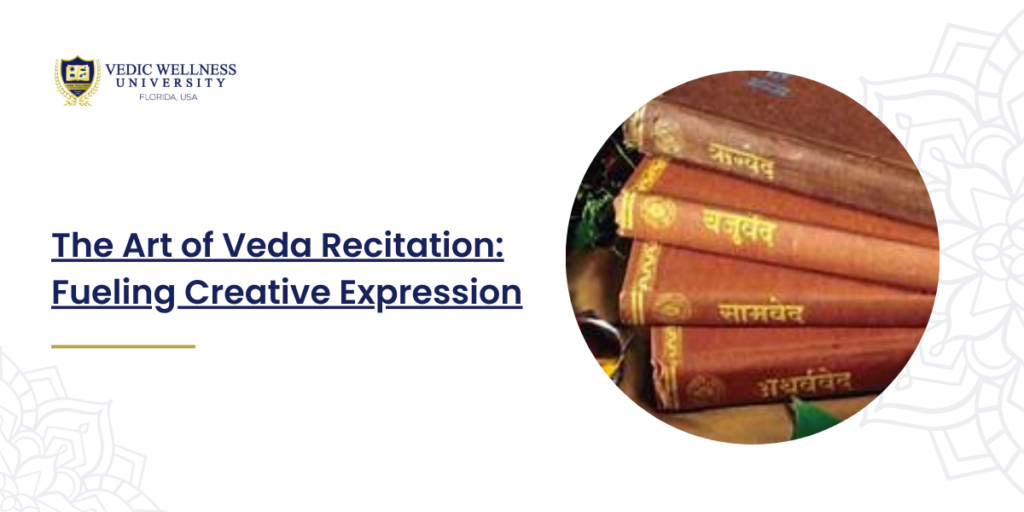The Art of Veda Recitation: Fueling Creative Expression

स्वाध्यायान्मा प्रमदः। (Swadhyayan Ma Pramadah) “Do not neglect self-study and recitation.” – Taittiriya Upanishad 1.11.1 Introduction The Art of Veda Recitation is a timeless tradition that transcends mere chanting. It is an intricate practice that involves precise pronunciation, rhythmic patterns, and deep spiritual connection. Originating from the ancient Vedic texts, this art form not only preserves the knowledge of the Vedas but also enhances one’s creative and spiritual expression. For centuries, the sacred Vedic practices have been revered for their ability to connect the practitioner with divine wisdom, elevate consciousness, and foster a sense of inner peace. In today’s global context, the significance of Veda recitation extends beyond cultural preservation—it is becoming a medium for creative spiritual expression and a tool for holistic wellness. This blog explores the profound impact of Vedic chanting techniques, the benefits of Veda recitation, and how the Art of Veda is a conduit for creative and spiritual expression. Through the lens of international perspectives, we delve into the categories of Vedic recitations, their relevance to modern practitioners, and how Vedic Wellness University is committed to preserving and promoting this ancient art. The Spiritual and Creative Dimensions of Veda Recitation Vedic chanting, or Vedadhyayana, is an ancient practice deeply rooted in the traditions of the Vedic culture. This practice is not only a method of preserving the sacred texts but also a pathway to spiritual awakening and creative expression. As the Rig Veda states: इन्द्रं वर्धन्तो अप्तुरः कृष्टीनां वीर्यं महत्। (Indram Vardhanto Apturah Krishtinam Veeryam Mahat) “Strengthen Indra, the mighty doer, for great deeds among people.” – Rig Veda 1.4.1 Vedic Chanting Techniques: Bridging the Mundane and the Divine The precise Vedic chanting techniques are designed to maintain the purity of the texts and their vibrational impact. These techniques require rigorous discipline and a deep understanding of phonetics, pitch, and intonation. The phonetic beauty of the Art of Veda lies in its ability to resonate with the cosmic vibrations, aligning the individual’s consciousness with universal energies. This alignment not only benefits spiritual growth but also serves as a creative spiritual expression that nurtures the soul. The creative expression manifested through Veda recitation is akin to an art form—one that combines devotion, discipline, and a profound understanding of sound and rhythm. The intricate patterns of Vedic chanting are believed to have a direct effect on the energy centers or chakras in the body, promoting balance, healing, and spiritual elevation. Sacred Vedic Practices: The Foundation of Holistic Wellness Sacred Vedic practices, such as the recitation of the Vedas, are deeply intertwined with the principles of Ayurveda. According to Ayurveda, the body, mind, and spirit are interconnected, and health is achieved when there is harmony between these elements. Veda recitation plays a crucial role in this holistic approach by purifying the mind and elevating the spirit, thus promoting overall well-being. Basic Principles of Ayurveda and Their Relevance to Veda Recitation: Categories of Veda Recitation and Their Unique Benefits The Art of Veda encompasses various styles and methods of recitation, each serving a distinct purpose. These categories are vital for advanced learners who seek to deepen their understanding of this sacred practice. 1. Samhita Paatha (Basic Recitation): This is the simplest form of Vedic recitation, where the verses are chanted in a straightforward manner. The focus is on correct pronunciation and maintaining the original intonations. 2. Padha Paatha (Word-by-Word Recitation): In this method, each word is chanted separately to maintain clarity and understanding of the individual components of the verses. 3. Krama Paatha (Sequential Recitation): This style involves chanting the verses in a specific sequence, emphasizing the rhythmic patterns and flow. 4. Jata Paatha (Complex Recitation): This advanced technique involves complex patterns where the words are repeated in a particular sequence to create a web-like structure of sound. 5. Ghana Paatha (Singing Recitation): This is one of the most advanced forms of Vedic recitation, where the verses are sung in a melodic fashion, resembling a musical rendition. The Role of Vedic Wellness University in Promoting the Art of Veda Vedic Wellness University is committed to preserving the Art of Veda through its comprehensive courses and programs. The university integrates ancient Vedic education with modern practices, providing a holistic approach to learning. Courses Offered at Vedic Wellness University By offering these diverse programs, Vedic Wellness University ensures that the rich tradition of Veda recitation is preserved and promoted on a global scale. Conclusion The Art of Veda is not merely an ancient practice; it is a living tradition that continues to inspire and uplift individuals around the world. Through Vedic chanting techniques, practitioners can experience a deep connection to the divine, foster creative spiritual expression, and achieve holistic wellness. The sacred Vedic practices provide a pathway to inner peace, self-realization, and creative fulfillment. For those interested in exploring the depths of this sacred art, Vedic Wellness University offers a unique opportunity to learn, practice, and preserve the Art of Veda. By integrating traditional wisdom with contemporary relevance, the university is dedicated to spreading awareness of this ancient practice and ensuring that its profound benefits are accessible to all who seek them. Embrace the journey of Vedic recitation, fuel your creative expression, and connect with the timeless wisdom of the Vedas. Through the art of Veda, let your soul resonate with the eternal vibrations of the universe.

